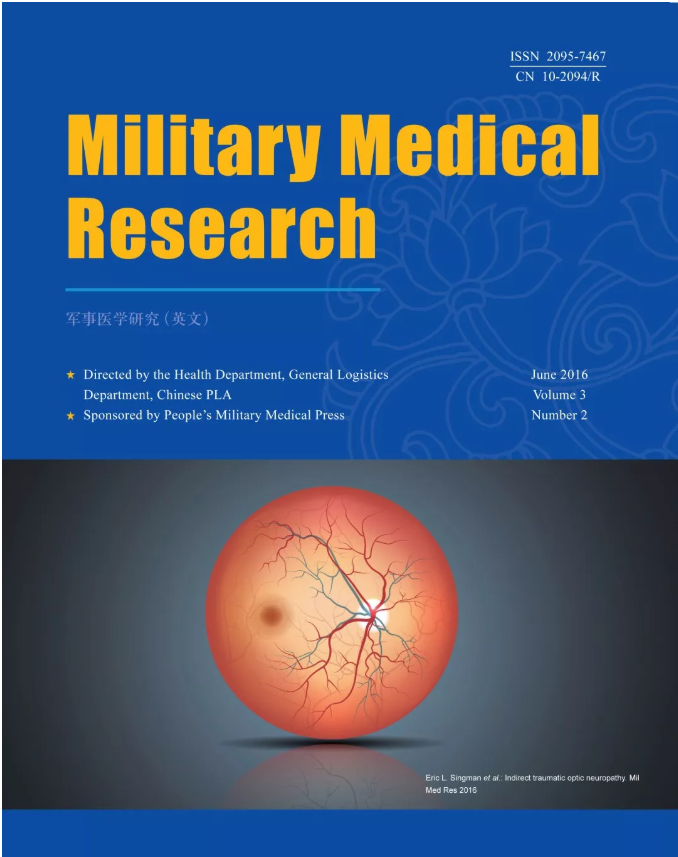Disentangling the effects of PTSD from Gulf War Illness in male veterans via a systems-wide analysis of immune cell, cytokine, and symptom measures
IF 16.7
2区 医学
Q1 MEDICINE, GENERAL & INTERNAL
引用次数: 0
Abstract
One-third of veterans returning from the 1990–1991 Gulf War reported a myriad of symptoms including cognitive dysfunction, skin rashes, musculoskeletal discomfort, and fatigue. This symptom cluster is now referred to as Gulf War Illness (GWI). As the underlying mechanisms of GWI have yet to be fully elucidated, diagnosis and treatment are based on symptomatic presentation. One confounding factor tied to the illness is the high presence of post-traumatic stress disorder (PTSD). Previous research efforts have demonstrated that both GWI and PTSD are associated with immunological dysfunction. As such, this research endeavor aimed to provide insight into the complex relationship between GWI symptoms, cytokine presence, and immune cell populations to pinpoint the impact of PTSD on these measures in GWI. Symptom measures were gathered through the Multidimensional fatigue inventory (MFI) and 36-item short form health survey (SF-36) scales and biological measures were obtained through cytokine & cytometry analysis. Subgrouping was conducted using Davidson Trauma Scale scores and the Structured Clinical Interview for Diagnostic and statistical manual of mental disorders (DSM)-5, into GWI with high probability of PTSD symptoms (GWIH) and GWI with low probability of PTSD symptoms (GWIL). Data was analyzed using Analysis of variance (ANOVA) statistical analysis along with correlation graph analysis. We mapped correlations between immune cells and cytokine signaling measures, hormones and GWI symptom measures to identify patterns in regulation between the GWIH, GWIL, and healthy control groups. GWI with comorbid PTSD symptoms resulted in poorer health outcomes compared with both Healthy control (HC) and the GWIL subgroup. Significant differences were found in basophil levels of GWI compared with HC at peak exercise regardless of PTSD symptom comorbidity (ANOVA F = 4.7, P = 0.01,) indicating its potential usage as a biomarker for general GWI from control. While the unique identification of GWI with PTSD symptoms was less clear, the GWIL subgroup was found to be delineated from both GWIH and HC on measures of IL-15 across an exercise challenge (ANOVA F > 3.75, P < 0.03). Additional differences in natural killer (NK) cell numbers and function highlight IL-15 as a potential biomarker of GWI in the absence of PTSD symptoms. We conclude that disentangling GWI and PTSD by defining trauma-based subgroups may aid in the identification of unique GWI biosignatures that can help to improve diagnosis and target treatment of GWI more effectively.通过对免疫细胞、细胞因子和症状措施进行全系统分析,从海湾战争疾病中析出创伤后应激障碍对男性退伍军人的影响
从 1990-1991 年海湾战争中归来的退伍军人中,有三分之一的人报告出现了认知功能障碍、皮疹、肌肉骨骼不适和疲劳等多种症状。这种症状群现在被称为海湾战争病(GWI)。由于海湾战争综合症的内在机制尚未完全阐明,因此诊断和治疗都以症状表现为基础。与该疾病相关的一个干扰因素是创伤后应激障碍(PTSD)的高发病率。以往的研究表明,GWI 和创伤后应激障碍都与免疫功能紊乱有关。因此,本研究旨在深入探讨 GWI 症状、细胞因子存在和免疫细胞群之间的复杂关系,以确定创伤后应激障碍对 GWI 中这些指标的影响。症状测量通过多维疲劳量表(MFI)和36项简表健康调查(SF-36)量表收集,生物测量通过细胞因子和细胞测量分析获得。使用戴维森创伤量表评分和《精神障碍诊断与统计手册》(DSM)-5结构化临床访谈进行了分组,分为创伤后应激障碍症状可能性高的 GWI(GWIH)和创伤后应激障碍症状可能性低的 GWI(GWIL)。数据分析采用方差分析(ANOVA)统计分析和相关图分析。我们绘制了免疫细胞和细胞因子信号转导指标、激素和 GWI 症状指标之间的相关图,以确定 GWIH、GWIL 和健康对照组之间的调节模式。与健康对照组(HC)和 GWIL 亚组相比,伴有创伤后应激障碍症状的 GWI 患者的健康状况较差。无论是否合并有创伤后应激障碍症状,在运动高峰期,GWI 与 HC 的嗜碱性粒细胞水平都存在显著差异(方差分析 F = 4.7,P = 0.01),这表明它有可能被用作一般 GWI 与对照组的生物标志物。虽然 GWI 与创伤后应激障碍症状的独特识别不那么明确,但发现 GWIL 亚组与 GWIH 和 HC 在运动挑战中的 IL-15 测量值上有明显区别(方差分析 F > 3.75,P < 0.03)。自然杀伤(NK)细胞数量和功能的其他差异突出表明,在没有创伤后应激障碍症状的情况下,IL-15 是 GWI 的潜在生物标志物。我们的结论是,通过定义基于创伤的亚组将 GWI 和创伤后应激障碍区分开来,可能有助于识别独特的 GWI 生物特征,从而有助于改进 GWI 的诊断和更有效的针对性治疗。
本文章由计算机程序翻译,如有差异,请以英文原文为准。
求助全文
约1分钟内获得全文
求助全文
来源期刊

Military Medical Research
Medicine-General Medicine
CiteScore
38.40
自引率
2.80%
发文量
485
审稿时长
8 weeks
期刊介绍:
Military Medical Research is an open-access, peer-reviewed journal that aims to share the most up-to-date evidence and innovative discoveries in a wide range of fields, including basic and clinical sciences, translational research, precision medicine, emerging interdisciplinary subjects, and advanced technologies. Our primary focus is on modern military medicine; however, we also encourage submissions from other related areas. This includes, but is not limited to, basic medical research with the potential for translation into practice, as well as clinical research that could impact medical care both in times of warfare and during peacetime military operations.
 求助内容:
求助内容: 应助结果提醒方式:
应助结果提醒方式:


